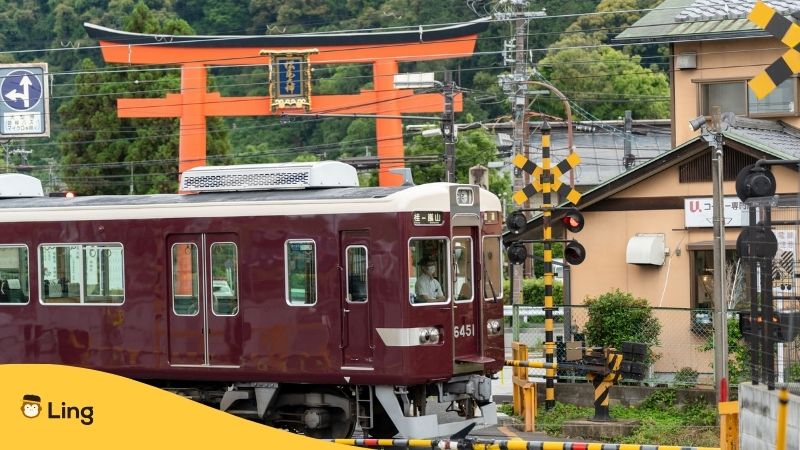Trust me, I’ve been there – stepping onto your first bullet train platform in Japan, bursting with excitement… only to be completely overwhelmed trying to decipher those polite yet super speedy Japanese train announcements blaring overhead! I must’ve gone the wrong way too many times before finally cracking the code.
But having experienced those linguistic rails, now I’m gonna let you in on the secrets to easily navigating Japan’s infamously complex train bulletins and announcements, whether you’re a first-time visitor or an intermediate Japanese learner!
From deciphering arrival and departure notices to understanding delay alerts, this guide will unlock even the trickiest train terminology and phrases in the Japanese language. No more aimless wandering lost in translation at the station for you, my friend!
Table of Contents

Why Consider Japanese Trains?
So why navigate those perplexing Japanese train announcements at all? Simple – trains are the most practical and efficient way to travel to Japan! Bullet trains, specifically, are world-famous for their impeccable budget-friendly coverage.
Consider this – even a basic cross-country train ticket costs significantly less than an economy flight or gas for a road trip. And Japan’s extensive rail network penetrates virtually everywhere, including hidden local gems inaccessible otherwise!
Can your budget handle slick Japanese Shinkansen bullet trains? Then, just a few hundred dollars transports you clear across the country in a fraction of the time, with none of the airport hassles. Even cheaper limited express lines balance cost and travel times nicely.
And have I mentioned Japanese trains’ world-class punctuality? We’re talking arrivals within 30 seconds of the schedule! Given Japan’s generally sky-high prices, trains remain surprisingly easy on the wallet, no matter your funds.
The best part? You actually have options for the type of train you can ride. Of course, the prices vary and this will depend on the exact city you’ll visit.
| English | Japanese Script | Japanese Pronunciation |
|---|---|---|
| Local trains | Local (ふつう) | Futsuu |
| Semi-express | Semi-express (じゅんきゅう) | Junkyuu |
| Rapid | Rapid (かいそく) | Kaisoku |
| Express | Express (きゅうこう) | Kyuuko |
| Limited Express | Limited Express (とっきゅう) | Tokkyu |
| Shinkansen | Shinkansen (しんかんせん) | Shinkansen |
@chopsticksontheloose Its the japanese announcement that gets us 🥹 #japan #train #visitjapan #tokyo
♬ Melody of Memories – Joelmusicbox
How To Buy A Japanese Train Ticket
When riding Japanese trains, you typically need to purchase some type of ticket before boarding. The type of ticket you need will depend on the train category and seating options:
Local and rapid trains generally don’t require reservations. You can purchase your tickets right on the platform from either ticket machines or windows. Then, feel free to sit in any non-reserved (jiyuu seki or 自由席) seat once aboard. These will usually be in the first three or last three train cars.
However, some longer-distance rapid trains have reserved seating (shitei seki or 指定席). You’ll need to reserve your seat ahead of time at the ticket counter. The agent can help suggest the best available seats and train times for your journey.
Inside the train, also keep an eye out for priority seating (yuusen zaseki or 優先座席) located near the doors. These special seats are reserved for elderly, pregnant, injured, or disabled passengers. Be prepared to vacate these seats if someone who needs them boards.
When waiting at the platform or already aboard, don’t be surprised if a uniformed conductor comes by to check tickets. They want to confirm riders are in their assigned seats or the correct train car.
Alrighty, travelers, I know you’re eager to set off on Japan’s famous bullet trains and scenic local railways. But first things first… you gotta know how to ask for tickets!
| English | Japanese Script | Japanese Pronunciation |
|---|---|---|
| One ticket to _____ Station, please. | _____ 駅まで切符をください。 | _____ eki made kippu o kudasai. |
| Please give me one ticket bound for _____. | _____ 行きの切符を一枚ください。 | _____ iki no kippu o issatsu kudasai. |
| I’d like to reserve a specified seat ticket to _____ Station. | _____ 駅までの指定席を予約したいのですが。 | _____ eki made no shitei seki o yoyaku shitai no desu ga. |
| Is there a fast limited express to _____ Station? | _____ 駅までの速い特急ですか? | _____ eki made no hayai tokkyu desu ka? |
| Excuse me. How much is it from _____ Station to _____ Station? | すみません。_____ 駅から_____駅までいくらですか? | Sumimasen. _____ eki kara _____ eki made ikura desu ka? |

Japanese Train Announcements
Japan’s high-speed trains and complex metro networks are famous worldwide. But the rapid-fire Japanese announcements blasting through the station have many visitors left scratching their heads amidst the details. Should you be changing platforms at the Tokyo Skytree? Was that the train heading west or due south?
Let’s get to know some of the best Japanese lines in this section.
Before Boarding The Train
Waiting on a Japanese platform for your sleek bullet train to slide in can get the nerves going! Thankfully, train announcements start preparing riders way ahead of arrival. So keep those ears open when standing by at the platform.
One phrase you’ll often hear is:
Mamonaku, densha ga mairimasu
Japanese script: 間もなく、 電車 が 参ります
This roughly means “The train will arrive soon” in polite language. Just a kind, verbal notice to get ready because your ride is rolling up within minutes!
Now, sometimes they spice this up by adding more precious details, like:
Mamonaku san-ban-sen ni Shibuya-yuki ga mairimas
Japanese script: まもなく三番線に渋谷行きが参ります。
Sounds tricky? Here’s the breakdown of every word:
- Mamonaku – soon
- San-ban-sen ni – on platform #3
- Shibuya-yuki – (the train) going to Shibuya
- Mairimasu – will arrive
So this gives the exact platform and destination! Very handy to know you’re in the right spot well in advance. Because it is dangerous when a fast train is approaching the platform, the next announcement will be like this.
Hakusen/ kiiroi sen no uchigawa ni sagatte, o-machi kudasai
Japanese script: 白線/黄色い線の内側に下がって、お待ちください。
This vital announcement urges riders to move away from the tracks for safety as it literally means: “Please move behind the inside white/yellow line and wait.”
Let’s break it down word by word:
- Hakusen/kiiroi sen – the white line/yellow line
- No uchigawa ni – on the inside
- Sagatte – move back
- O-machi kudasai – please wait
When You’re On The Train
Congrats, you’ve boarded your train and scored a seat in a spotless cabin buzzing with polite chatter and city views zooming by. Everything seems to be rolling smoothly as stations tick past. But don’t relax too soon! Pay attention because conductors might pipe up with train updates you need to know.
Kono densha wa, ___sen, ___iki desu
Japanese script: このでんしゃは、___せん、___いきです。
This means, “This train is the ___ Line train bound for ___.”
You can also hear this:
Kono densha wa,, ___, ___iki desu.
Japanese script: このでんしゃは、,,いきです。
Meaning “This train is going to __ Station, __ Station, and __ Station.”
While it’s easy to be mesmerized by Japan’s speedy trains and picturesque landscapes zooming past the windows, you still gotta keep your listening ears on inside the train.
| English | Japanese Script | Japanese Pronunciation |
|---|---|---|
| Priority Seat | 優先席 | Yūsen-seki |
| Please be quiet | 静かにしてください | Shizuka ni shite kudasai |
| Emergency Exit | 非常口 | Hijōguchi |
| Luggage Area | 荷物置き場 | Nimotsu okiba |
| Stop Button | 停止ボタン | Teishi botan |
| Train Car Number | 車両番号 | Sharyō bangō |
| Non-Smoking Area | 禁煙エリア | Kin’en eria |
| Restroom | トイレ | Toire |
| For Wheelchair | 車椅子用 | Kurumaisu-yō |
| Door will open on the left/right | ドアは左/右に開きます | Doa wa hidari/migi ni hirakimasu |
Ready To Visit Japan?
Well, there ya have it, friends – we’ve covered all the lingo and cultural insights you’ll need to master Japan’s incredible trains! And if you’d like to unlock insider travel tips and practical language skills for visiting Japan, be sure to check out the Ling app!
Available on iOS and Android, Ling helps you build real conversational skills in languages like Japanese. I wish I had Ling’s bite-sized lessons, easy games, and virtual flashcards back when I mumbled my way through those first train stations! Give Ling a try now!



































































